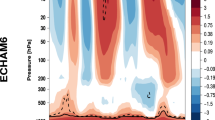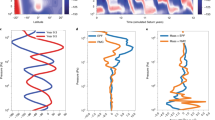Abstract
Numerical integrations of a one-layer hemispheric model of the winter stratosphere have been carried out at very high resolution (of the order of a fraction of a degree of latitude). The numerical experiments simulate planetary-wave breaking and polar-vortex erosion under conditions far closer to the real winter stratosphere than those assumed in earlier, 'critical-layer' models. The model has implications for stratospheric photochemistry and the Antarctic ozone hole problem.
This is a preview of subscription content, access via your institution
Access options
Subscribe to this journal
Receive 51 print issues and online access
$199.00 per year
only $3.90 per issue
Buy this article
- Purchase on Springer Link
- Instant access to full article PDF
Prices may be subject to local taxes which are calculated during checkout
Similar content being viewed by others
Author information
Authors and Affiliations
Rights and permissions
About this article
Cite this article
Juckes, M., McIntyre, M. A high-resolution one-layer model of breaking planetary waves in the stratosphere. Nature 328, 590–596 (1987). https://doi.org/10.1038/328590a0
Received:
Accepted:
Issue Date:
DOI: https://doi.org/10.1038/328590a0
This article is cited by
-
Lagrangian study of the final warming in the southern stratosphere during 2002: Part I. The vortex splitting at upper levels
Climate Dynamics (2019)
-
Spatial chaos on surface and its associated bifurcation and Feigenbaum problem
Nonlinear Dynamics (2015)
-
Polar night vortex breakdown and large-scale stirring in the southern stratosphere
Climate Dynamics (2010)
Comments
By submitting a comment you agree to abide by our Terms and Community Guidelines. If you find something abusive or that does not comply with our terms or guidelines please flag it as inappropriate.



